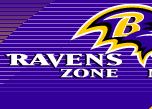|
|
Head Coach
Born: February 28, 1954, Fairborne, OH
2nd Year w/Ravens
22nd Year Coaching
9th Year NFL
Brigham Young University
|
|
 |
|
Brian Billick
|
|
|
|
|
|
|
Brian Billick enjoyed a successful season with the 1999 Ravens, his first stint as a head coach at any level. The 8-8 Ravens produced the most victories in the franchise�s four-year history, won the most consecutive games (4), the most road games (4), including the first victory at Pittsburgh, and finished with the best-ever Ravens� defense (2nd in the NFL). But Coach Billick didn�t take a bow for this progress.
Immediately following the final game last December, Billick gathered the Ravens and said: �We�ve raised the bar. We can�t go back. We are at a new level, and we will move forward. Our fans, the media, the organization - all have new expectations for us. They�re justified in wanting more success. Eight and eight is not going to get it anymore. We need to take the next steps to become a playoff team.�
The Ravens earned the .500 mark in the tough AFC Central, plus a new-found respect around the league, thanks to the strong defense (in the top two in the NFL in five key categories) and an improving offense. The offense evolved into an efficient unit, averaging 25.4 points and 322 yards per game over the final nine games (record 6-3), up from 13.5 points and 268.4 yards per game in the first seven contests (record 2-5). The Ravens outscored their final nine opponents, 229-142, including a 41-14 victory over AFC Champion Tennessee on Dec. 5. QB Tony Banks, who became the Ravens� starter in game seven, threw a career-high 17 TD passes and a career low eight INTs in his 10 starts.
Billick was one of nine new head coaches in the league last season, one of six first-time head coaches, and his 8-8 mark was better than all but Gunther Cunningham (Kansas City) and Mike Holmgren (Seattle), who both finished 9-7. He was named co-Rookie Coach of the Year (along with Cunningham) by College & Pro Football Newsweekly.
During this offseason, Baltimore added weapons to the offense with the signing of seven-time Pro Bowl TE Shannon Sharpe and with the drafting of RB Jamal Lewis (Tennessee), WR Travis Taylor (Florida) and QB Chris Redman (Louisville). �The old saying that states �you win championships with defense� doesn�t work anymore. You have to have to be able to score. You have to have big plays as part of your arsenal. We need to add more �explosives� to our attack,� Billick said.
Billick became the second head coach in Baltimore Ravens� history when he accepted a six-year contract from owner Art Modell on January 19, 1999. Billick, the highly successful offensive coordinator for the Minnesota Vikings from 1994-98, directed a Vikings� attack that set a variety of NFL and team records in a 15-1 1998 campaign.
�When we began our search, we couldn�t talk with Brian because his team was in the playoffs,� Modell said. �Instead, we talked with 28 people who had some direct association with Brian.�
�Everything we heard about Coach Billick told us to wait for him,� explained David Modell, the Ravens� president. The younger Modell and Ozzie Newsome, the Ravens� vice president of personnel, helped Art during the head-coaching search. �We talked with everybody from the person who introduced Brian to his wife, Kim, to Dennis Green, to Tony Dungy, to Bill Walsh. All of these people painted a picture of a person and a coach ready to take the next step up in the NFL.�
�I was very fortunate,� Billick said. �Usually there is one �hot� coordinator and one job available. I had other opportunities, but I picked Baltimore.�
Billick, 46, was the architect of a Minnesota offense that in 1998 shattered the NFL record for most points scored in a season (556), breaking the old mark (541) set by the 1983 Washington Redskins. The �98 Vikings scored 53 of 56 times they were inside the 20. In their two playoff games, the Vikings scored 41 points against the Arizona Cardinals and 27 against Atlanta in the NFC Championship game. Minnesota tied for the NFL lead with 41 touchdown passes, shattering a team mark, and scored over 100 points in each quarter for the first time in team history. Minnesota ranked second in the NFL (behind San Francisco) with a team-record 6,262 total net yards and first in the league with 4,328 yards passing. QB Randall Cunningham, who replaced the injured Brad Johnson early in the season, led the NFL with a 106.0 QB rating and set a Vikings� record with 34 TD passes. Cunningham�s favorite target was rookie WR Randy Moss, who burst onto the NFL scene with 17 TD receptions.
Over his five full seasons, Billick guided the Vikings into the top five in the NFL in yards per game, passing yards per game, completions and third down conversions. Under Billick�s guidance, the Vikings recorded their top three offensive seasons (1998, 1995 and 1994), and five of the top 10 offensive seasons in team history. Most importantly, the Vikings advanced to the playoffs all but one season (1995) during Billick�s tenure. Minnesota played postseason games in 1993-94 and 1996-98.
Billick joined the Vikings in 1992 as tight ends coach. �When he came here, Brian was the only guy with a computer, and now all the coaches use them,� said Vikings� head coach Dennis Green. Brian was named offensive coordinator three games into the 1993 season, and Minnesota�s production increased dramatically: The Vikings went from 264.8 yards per game over the first six weeks of the season to a 323.3-yard average over the final 10 games. During a three-game winning streak that propelled the Vikings into the playoffs, the offense averaged over 21 points and 351 yards per game. In Billick�s first full season as offensive coordinator in 1994, the Vikings finished second in the NFL in passing yards (4,324) � now the third-most in team annals. Minnesota won the NFC Central Division title, but lost to the Bears in the first round of the playoffs.

In 1995, the Vikings failed to qualify for the postseason, but the offense scored a then-team record 412 points and gained 5,938 yards. WR Cris Carter set a Vikings� record with 17 TD receptions (tied by Moss). QB Warren Moon set a then-team mark with 33 TD passes (topped by Cunningham�s 34). The 1996 Minnesota team qualified for a Wild Card berth with a 9-7 mark, as Carter grabbed 96 passes and Jake Reed placed second in the NFL with 1,320 receiving yards. Brad Johnson established himself as one of the game�s top quarterbacks, finishing third in the NFL with an 89.4 QB rating. Johnson threw 17 TD passes in only eight starts. The Vikings once again made the playoffs in 1997, qualifying as a Wild Card with a 9-7 record. The Vikings lost starting quarterback Brad Johnson and center Jeff Christy in the middle of the season. Johnson finished fourth in the NFC with an 84.5 QB rating and threw 20 TD passes despite missing three games. RB Robert Smith set team records for rushing yards in a season (1,266), 100-yard games (six) and finished third on the team with 37 receptions. Minnesota�s rushing attack finished second in the NFC with 2,041 rushing yards. They defeated the Giants, 23-22, in the Wild Card round, before dropping a 38-22 game at San Francisco in the Divisional Playoffs.
Before his appointment with the Vikings, Brian was a Stanford assistant from 1989-91 under Coach Green. He helped in the development of wide receivers Ed McCaffrey, Chris Walsh and tight ends Ryan Wetnight and Jim Price. All four went on to NFL careers. Prior to Stanford, Billick spent three seasons as offensive coordinator at Utah State (1986-88). Brian helped develop QB Brent Snyder, who set school passing marks with 2,887 yards in 1987 and 3,218 yards in 1988. When he arrived at Utah State, the team was ranked 107th out of 108 NCAA Division 1-A teams offensively. In his final two seasons as coordinator, the Aggies ranked in the top 10 in total offense.
Brian coached receivers, tight ends and quarterbacks at San Diego State from 1981-85 and held the added responsibility as recruiting coordinator. Aztec QB Todd Santos set all-time NCAA passing records during Billick�s tenure. Brian also coached WR Webster Slaughter and TE Rob Awalt (the NFL�s rookie of the year in 1987). �San Diego State gave me a great chance to learn from a good offensive mind like Doug Scovil, to learn what it meant to coach, to be a professional,� Billick said. �Doug wasn�t particularly interested in doing a lot of administrative things, so I absorbed a lot of those and continued to learn what an organization needs to do to function.�
Brian began his coaching career as an assistant at the University of the Redlands in 1977, while helping coach a local high school team at the same time. He spent the following year (1978) as a graduate assistant at Brigham Young University. At BYU, he worked with tight ends and the offensive line. Following that season, Brian was assistant director of public relations for the San Francisco 49ers in 1979-80. Two years earlier (1977), Billick had been drafted by the 49ers in the 11th round, was released and had a brief stint with the Dallas Cowboys. Brian earned All-Western Athletic Conference honors and honorable mention All-America in 1976 as a tight end at Brigham Young University. In 1976, he caught 20 passes for 338 yards and a touchdown. Brian played linebacker at Air Force as a freshman before transferring to BYU.
Since coming to Baltimore in January of 1999, Billick has enthusiastically helped improve the community. As he did in his first few months with the team, Billick continued to make countless appearances to help a variety of charities and foundations raise awareness and funds this offseason. Billick gives extra time to the Central Maryland United Way and to the Living Classroom Foundation, where he serves on the board of directors. Brian�s wife, Kim, joins him in many of these community projects, plus she has helped Baltimore�s Red Cross with a number of important projects.
Billick was born in Fairborne, OH on Feb. 28, 1954, but grew up in Redlands, CA. He is the fourth of five children. Billick earned three letters in both football and basketball at Redlands High School. He was a Helms Scholar-Athlete as a senior. Brian earned a B.A. in communications from BYU, where he also pursued a master�s in communication. He and Kim (who used to work as an assistant to Tex Schramm of the Dallas Cowboys) have two daughters: Aubree (3/5/84) and Keegan (6/26/89).
1978 (Brigham Young); 1979 (Redlands); 1981-85 (San Diego State); 1986-88 (Utah State); 1989-91 (Stanford); 1992-98 (Minnesota Vikings); 1999-2000 (Baltimore Ravens, head coach).
There were nine first-year coaches in the NFL in 1999,
and six first-time head coaches
| Head Coach | Team | Records |
|---|
| Gunther Cunningham | Kansas City Chiefs | 9-7 |
| Mike Holmgren* | Seattle Seahawks | 9-7 |
| Brian Billick | Baltimore Ravens | 8-8 |
|---|
| Ray Rhodes* | Green Bay Packers | 8-8 |
| Mike Riley | San Diego Chargers | 8-8 |
| George Seifert* | Carolina Panthers | 8-8 |
| Dick Jauron | Chicago Bears | 6-10 |
| Andy Reid | Philadelphia Eagles | 5-11 |
| Chris Palmer | Cleveland Browns | 2-14 |
|
* denotes had previous NFL head coaching job.
Last updated on 9/6/00.
 |








